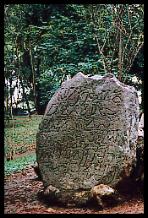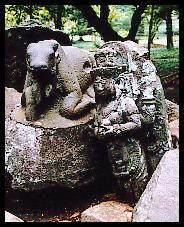

The history of Java starts a long long time ago since it is on the banks of the Trinil river , just in the north of Solo in central Java , that were discovered in 1892 some bones, that one dated of more than one million years, by a young Dutch doctor impassioned by the new theories on the evolution of the species of Charles Darwin, Eugène Dubois.
It
is "the man of Java", the famous Pithecanthropus . Many
other bones, gone back to several hundreds of thousands of years,
were discovered thereafter in the same area, in particular in
Sangiran.
The more recent history, that which interests us today, brings back us a few centuries before our era, with what we could call the culture of the bronze drums.
Towards the 5th Century B.C., in the area of Dong Song, in the north of current Vietnam, were produced by mountain populations, initiated with the art and the technique of bronze by the close and expert Chinese, drums in bronze metal, makers of rain. They are objects approximately 50 cm in diameter and as much height. On the center of the plate of these drums, is often represented the sun in the shape of a star whose the numbers of branches is variable. The remainder of the plate is engraved with design always related to water: symbol of water, the moon, stylized dragons , and even with boats or frogs, sometimes presented in forms of small sculptures welded onto the plate. For these rice growers whose existence depended on the rains, these drums, which were posed flat, giants model of the drums used by the Shamans, only qualified to address themselves to the gods, when they were struck, emitted a sound which imitated the croaking of the frog which one says that it makes come the rain.
These populations, rejected and pushed back by the advance of Chinese Han, will move always more in the south and as far as Indonesia where one found many drums identical to the Vietnamese model. However, nobody can say yet with certainty if the drums found in Indonesia were brought from Vietnam by the immigrants or if they were manufactured locally because one also found some moulds allowing to make bronze drums according to the process known as of lost wax.
Largest of all these bronze drums known in the world is in Bali. It is a drum, of a model typically Indonesian, whose form points out a little that of a sand glass. It measures 1 m 86 top for 1 m 62 broad. It is called "the moon of Pejeng " because of a local legend which says that one day the chariot of the moon would have lost a wheel whose this superb bronze drum would be finally the emanation. One can, with difficulty, see this object, because it is perched with four meters in height, in one of the buildings of the temple Pura Panataran Sasih at Pejeng. The apron of this drum (below) is particularly beautiful.
From the very start of our era, the trade between China, the Southeast Asia and India was common. They were done especially by the Malayan navigators who were the only ones to know the seasonal movements of the trade winds, which enabled them to go to Madagascar while crossing the seas, whereas the Indian boats made only coastal traffic.
From the 2nd century, the traditional way of exchange, the Road of Silk, was cut for reasons of conflicts, so that the sea route of the south will become the obligatory passage.
To the 5th C., China will entrust the security of the trade of its goods to the ships of the kingdom of Srivijaya from Sumatra which controls all the passages and the ports of the Straight of Malacca with the help of the hackers who infest these seas and hail all the other boats for the account of Srivijaya. The control of the China Sea by the kingdom of Srivijaya will practically last until its disappearance to the 13th century. During all this period, one will practically not see Chinese boats being ventured to ensure a maritime line.
The monks and the priests of India benefited from this commercial development to take these ships, and to come to the meeting from the small kingdoms incipient from the East Indies, perhaps upon request even of some of their heads, who would have understood the personal prestige that they could get while having "wise" foreigners on their sides.
It is to the 5th century A.C. that the first traces of the hindo-bouddhistic civilization appear in Indonesia, with two completely different forms:

It should not be forgotten that during one thousand years, from 5th to 15th C., the indianized kingdoms existed in the west of Java. One speaks little about it because, unfortunately, they did not leave many archaeological traces, because most of their temples were built of wood. The only temple rebuilt that one can see is Candi Cangkuang near Garut. However, the carried out excavations made these last years allowed the discovery of several sites in the surroundings of Karawang, 50 km in the east of Jakarta, and also in the area of Ciamis.
The
last Hindu kingdom of western Java, the kingdom of Pajajaran, was
destroyed in 1587 by the army of princes of Banten, who had
seized Sunda Kelapa (Jakarta) 60 years earlier.
The
kingdoms of western Java (Sunda) could not reach a great width
because the rajahs could not establish major
links with the close populations. Indeed, there was no sawah
(irrigated rice plantation), whose organization
of the system of irrigation bound the peasant to the
kraton ( the residence of the head).
The organization of the agrarian kratons of Java :
The smallest community in old Java was the wanua, an autonomous traditional and community system led by the group of "elder " chaired by the father: rowed or tuha.
The following stage was the meeting, for economic reasons of several wanuas. This unit was directed by a Raka, "the elder brother " certainly belonging to the Rama, who chairs the jurisdiction, watak, of several areas. Perhaps this institution, undoubtedly pre-Hindu, were created for the organization of the distribution of water in the sawahs of several wanuas, starting from the same water point.
From the progressive centralization of the organizations ensuring, the distribution of the services and the goods, and the political and legal administration, emerged the kraton, grouping of consuming civil servant, compared to the wanuas, producers of goods.
With the arrival of the Brahmans from India, some Rakas could be elevated at the rank of Maharaja, and to be sanctified, involving the royal line.
The inscription of 778 found in Kalasan says to us: "the Buddhist priests raise the temple for the king Sailendra with the agreement (financial) of Maharaja Rakarayan Panangkaran " It was apparently the first to carry the title of Sri Maharaja. Thus, king Sailendra, who seems to be of a dynasty of Funan origin (according to G. Coedes), does not have ground nor of income. It is the maharaja which has the incomes. It is him who will finance the construction of the temple, it is him who will offer the ground necessary to the construction of the sanctuary, it is him who will give the rice plantations so that the monks, with the peasants and the slaves, can work them to provide for the existence of the religious community.
Then there was, following the wars, a centralization of all kratons them starting from king Balitung, Raka of Batukura, in 907.

Not far from there, on the slopes of the Ungaran mount, is the group of nine temples of Gedong Songo (nine buildings) , which date about from the same time.
A few decades later, from 778, Sailendra (Lords of the mountain), will cover the area of Yogyakarta of dedicated monuments, initially with the Buddha, then from 780 with the bouddhistic worship of the five Jina.
Among all these constructions, one will raise obviously the gigantic project and, say it a little insane, of Borobudur, whose construction will be done by stages, and will be completed some 60 years later towards 840, by Sanjaya who became kings of the area after the wedding of the Maharaja Sanjaya Pitakan with the daughterof the king Sailendra.
Showing a great religious tolerance, the new masters, will finish the Buddhist monuments started with Sailendra (which them will take the control of the sumatran kingdom of Srivijaya). Sanjaya of the first Mataram kingdom, will also build large temples dedicated to hindu Trimurti, and in particular the great complex of Prambanan. Married to a princess Sailendra (the daughter of Samaratunga and sister of the future king de Srivijaya Balaputra), king Rakai Pikatan will even make build Buddhist temples like Candi Sari and Candi Plaosan.
From the medium of the 9th C.,for still unexplained reasons - big problems of irrigation, natural catastrophe in the form of an explosion of the Merapi volcano -, the kingdoms apparently will move towards the Northeast of Java but, with a little of inscriptions and monuments, one will lose their traces.
However, in 929, will emerge the Isana kingdom under the impulse of Mpu Sindok of which one of the wives was the girl of last king Sanjaya of Mataram. It is of this line that will emerge hundred years later Airlangga, son of the great-granddaughter of Mpu Sindok, Mahendratta, and of a father who was the balinese prince Udayana.
Airlangga, died in 1049, will end up controlling most of east Java that it will share for its succession in two kingdoms between his two sons, the kingdom of Jangala and the one of Kadiri. The first will quickly be absorbed by the second, and the kingdom of Kadiri will develop until extending its domination on the islands external to Java. Large monuments will be built, but the dynasty will die out at the time of assassinated, in 1222, of last king de Kadiri, Kritajaya, by Ken Angrok, an who the same year had assassinated the regent of Tumapel (another name for Janggala), then married his wife Ken Dedes.
Ken Angrok, now the new king, will found the Singhosari dynasty which will be essential until 1292, date of the murder of the last king, Kartanegara, and destruction of the city by king of Mojopahit, Wijaya, helped by the Chinese army sent by Koubilaï Khan in reprisals to the affront which Kartanegara had made to him , who not only have refused to pay tribute to China, but moreover had returned the emissaries of Koubilaï to China after having terribly mutilated them.
Mojopahit, installed in Trowulan, 50 km south of Surabaya, after having turned over their weapons against the Chinese and to have rejected them to the sea, imposed their dynasty and their power until 1500, in particular under the reign of king Hayam Wuruk and his Prime Minister, Gajah Mada. It is one of the most prestigious dynasties of the history of Java - they controlled the China Sea to Taiwan - so much so that the current sultans of Yogyakarta and Solo claim to be their descendants.
But, the conversion of part of the population, then certain princes Mojopahit to Islam, will ring the knell of the indo-Javanese epic of Indonesia. Sanctuaries nevertheless will be still built in the mountains of Java until the medium of the 16th C., after what, hindouism will concentrate on the close island of Bali, already controlled by Mojopahit.
Some Javanese populations still maintain, in particular around the Bromo mount, worships and rituals related to the old indo-Javanese traditions.
![]()